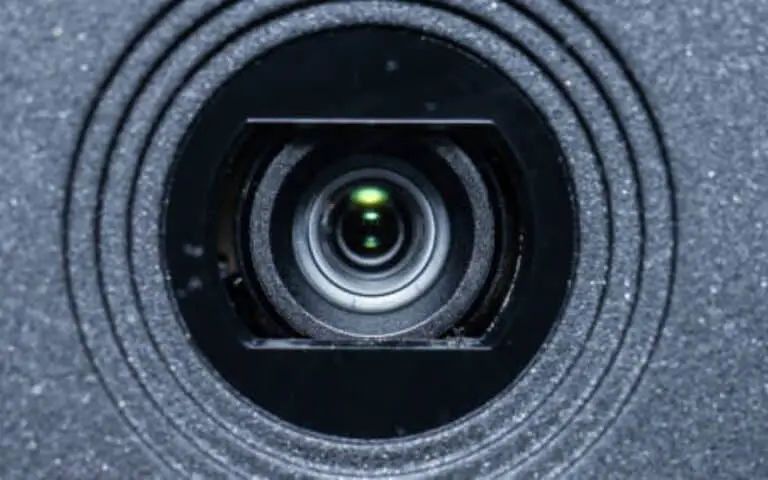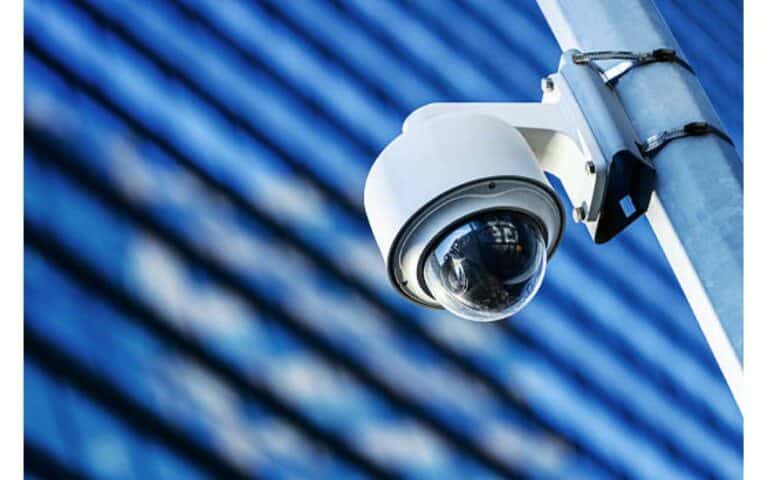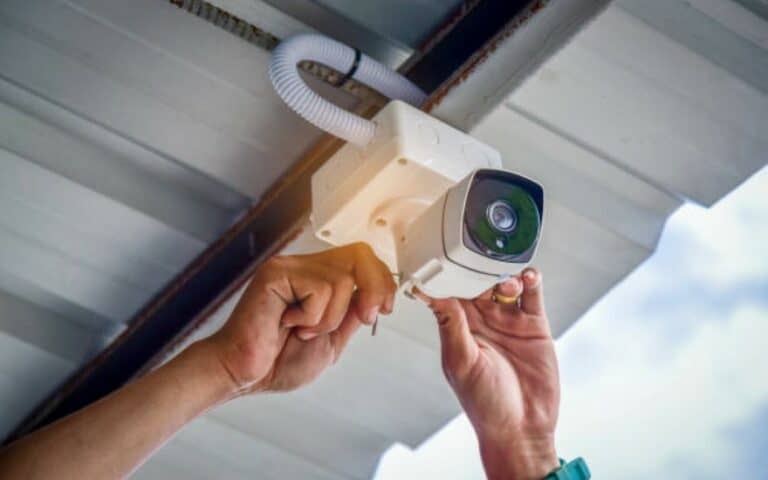Installing security cameras at home or in your workplace can help you keep an eye on your property and protect it. With the increasing crime rate, having a security camera system in place can provide a sense of security and peace of mind. However, setting up a security camera system can seem like a daunting task, especially if you have no prior technical knowledge. In this blog post, I’ll guide you step by step on how to install security cameras in your home or office, making the process less intimidating. From selecting the right equipment to placing the cameras in the right spot, we’ve got you covered!
How to install security cameras: 15 Steps
Installing security cameras is an effective way to enhance the safety and security of your home. To start, residents can assess their home and determine the areas that require video coverage. They should also plan out the camera installation process and note down the necessary supplies and distances to power sources.
1. Determine the best location for your security cameras
When it comes to installing security cameras, determining the best location is crucial. Homeowners should take a good look at their property and identify potential trouble spots that need coverage. Dark spaces or entryways that may be tempting to criminals should be given priority for camera placement. It is important to position cameras in logical places that provide footage of these areas.
A quick sketch of the property can be useful for planning camera installation, taking into consideration power sources, existing wiring, and Wi-Fi router distance. Homeowners should also think about the camera type and any additional supplies needed. To ensure safety and avoid drilling into existing wiring, it is recommended to check for wiring behind walls before installation.
If installing a wired camera, homeowners should turn off the power at the breaker box. Finally, if the installation process seems overwhelming, homeowners can hire a professional for a fee. [3][4]
2. Choose the type of camera that suits your needs
When choosing a security camera that suits your needs, it is important to consider factors like wired or wireless, indoor or outdoor, motion sensing, and remote viewing. Wireless cameras are the easiest to set up without drilling or running cables through your house, but the quality can be sub-par the further they get away from the receiver.
Wired cameras, on the other hand, are an excellent choice for larger properties but require more steps in the installation process. Indoor cameras are designed for inside use while outdoor cameras are built to withstand harsh weather conditions. Motion sensing cameras operate at low power until they sense movement, saving recording space and energy.
Finally, remote viewing is a feature found in more expensive systems and allows you to stream footage to your laptop or smartphone. Consider all of these factors before choosing a security camera that will meet your needs. [5][6]
3. Prepare your tools and equipment
Preparing your tools and equipment is an essential step in installing security cameras around your home or business. To get started, make sure you have the necessary tools such as a drill, screwdriver, finishing nail, and hammer. If you’re attaching the camera to a wall, using a drill will make things easier.
If you don’t have one, a screwdriver, finishing nail, and hammer will suffice. Don’t forget to charge your camera before beginning the installation process. If the camera comes with a power cord, you can skip this step. You’ll also need to download the app that the camera uses to your phone and connect it to the camera.
Make sure to read the quick start guide included in the camera’s box for instructions on how to do this. By following these steps, you can prepare your tools and equipment and be ready to install your camera in no time. [7][8]
4. Make a plan for your camera installation
When considering installing security cameras, residents need to make a plan to ensure they are positioned in the right places to provide footage of any trouble spots. The first step is to take a good look at the home and identify any areas that may need video coverage.
Once they have made a quick sketch of the house, they can start planning out where the cameras should be placed. It is essential to think about the types of cameras required, any additional supplies necessary, and the distance to power sources and the Wi-Fi router. Residents need to check for any wiring that may be behind walls or roofs before drilling into any surface.
Installing security cameras can be a DIY project, but for those who prefer, a professional installer is available. Overall, following a step-by-step installation guide will help residents install their security cameras with ease and feel secure in their homes. [9][10]
5. Install the mounting bracket or base for your camera
When installing a security camera, the first step is to install the mounting bracket or base. This provides a stable support for the camera to ensure it stays in place and captures footage effectively. The base should be securely attached to a wall, post, or other surface where the camera will be mounted.
Most cameras come with self-drilling screws that can be easily installed using a regular electric drill. It’s important to pay attention to where the base is being installed to ensure the camera will be able to capture the desired angle and provide the best coverage. Once the base is securely attached, it’s time to attach the camera and adjust its position and focus.
Proper installation of the mounting bracket or base is crucial to ensure that the camera stays properly aligned and captures the desired footage. [11][12]
6. Run the cable or wiring for your security camera
To run the cable or wiring for a security camera, the homeowner needs to plan the location of the camera beforehand. They should decide where to place the camera and check for any wiring behind walls, ceilings, or roofs before drilling into any surface.
They will also require some basic tools like a drill, flathead and Phillips-head screwdrivers, needle-nose pliers, and fish tape in case of a wired camera installation. For outdoor installations, they may also need a tube of caulk or sealant to ensure a leak-free bond. After gathering all the necessary tools and supplies, the homeowner can begin running the wiring, making sure to keep the cable neat and tidy.
It is important to remember to turn off the power at the breaker box before drilling any holes. This step will ensure safety, and the homeowner may avoid potential hazards that could result in harm or property damage. [13][14]
7. Connect the camera to your power supply
Connecting the camera to the power supply is a crucial step in installing security cameras. One needs to ensure that the camera is receiving a stable and consistent power supply for optimum performance.
When installing a wired camera, one must connect the camera’s power cable to the power source, either an outlet or a junction box. For battery-powered cameras, one must insert the batteries and connect the camera to the Wi-Fi network. The power source must be close to the camera for easy installation and use.
Some cameras come with a power over ethernet (PoE) option, meaning they get their power and data from an ethernet cable, making installation more manageable. It’s important to ensure that the power supply is turned off when installing a wired camera for safety reasons. Once the camera is connected to the power supply, one can proceed to adjust its positioning and focus. [15][16]
8. Adjust the positioning and focus of your camera
Once the security camera is mounted and secured, the next step is to adjust the camera’s positioning and focus to ensure maximum coverage. This is an important step in the installation process, as improper positioning can result in blind spots or ineffective coverage.
The camera should be aimed at the area of interest with the appropriate angle and height to capture the necessary footage. It’s also important to adjust the focus to ensure clear and sharp images. This can be done by accessing the camera’s settings and adjusting the focus ring until the desired clarity is achieved.
It’s important to take the time to adjust the positioning and focus of each camera to ensure that they are providing the best possible coverage for the intended area. By doing this, residents can increase their home security and business owners can protect their property from criminal activity. [17][18]
9. Finish securing your camera to its mounting bracket or base
After positioning the security camera in the desired location, the next step is to securely attach it to its mounting bracket or base. This is an essential part of the installation process, as a poorly secured camera can be easily tampered with or even fall off. To ensure stability, residents should use the appropriate screws and mounting equipment recommended by the manufacturer.
It’s important to ensure the camera is secured tightly, but not so tight that it causes damage to the camera or the mounting device. Some cameras may come with adjustable arms to make the process easier. Once the camera is properly secured, residents can move on to the next step of testing the camera to ensure it’s working properly. [19][20]
10. Test your camera to ensure it’s working properly
After installing the security cameras, it’s crucial to test them to ensure they’re working correctly. First, residents should check the hardware and software to see if any updates or adjustments are necessary.
Next, they can use the camera’s live view function to check the angle and image quality in different conditions. They should also verify that the motion detection and recording features are working correctly, and that the cameras are capturing the areas they need to monitor.
Finally, residents should test the cameras at different times of the day to ensure proper lighting and visibility. If they notice any issues, they can troubleshoot or contact the manufacturer for support. Testing the cameras will give residents peace of mind that their surveillance system is functional and ready to protect their home. [21][22]
11. Repeat the installation process for additional cameras
After successfully installing the first security camera, residents can repeat the process for additional cameras to increase their overall coverage area. They can refer to their initial sketch of the home to determine where they need more cameras and where they want to position them.
It is important to make sure the cameras are placed in logical spots that can provide clear footage of trouble areas. Residents should also make sure they have all the necessary tools and supplies, such as drills, screwdrivers, and ladder, before beginning the installation process.
Once all the cameras are installed, they need to be connected to the same network or recorder, and their settings should be adjusted as needed. It is also essential to label each camera and create a system to manage them. Finally, residents should familiarize themselves with their camera’s software and features to ensure they are using their security system to its full potential. [23][24]
12. Connect all your cameras to the same network or recorder
After positioning and installing the security cameras in the desired locations, the next step is to connect them to the same network or recorder. This is a crucial step that ensures all the cameras work together to provide complete surveillance coverage.
The cameras can be connected to a Network Video Recorder (NVR) or a Digital Video Recorder (DVR). The installation process is relatively straightforward, and users only need to follow the manufacturer’s instructions. It’s essential to ensure that all the cameras are connected correctly to avoid any disruptions in the video feed.
Once all the cameras are connected and functioning correctly, users can configure their settings as needed. Lastly, users should label each camera and create a system to manage them effectively. The entire camera system can be managed through software that comes with the cameras or the NVR/DVR. It’s crucial to get familiar with the camera’s software and features to ensure optimal usage. [25][26]
13. Configure your camera settings as needed
Once the security cameras are installed, it’s important to configure their settings. This includes adjusting things like motion detection sensitivity, camera resolution, and recording schedules. Residents should take the time to customize the settings to fit their specific security needs.
For example, they may want to set up push notifications to their phone or email if the camera detects motion. They may also want to adjust the camera’s field of view to cover a wider or narrower area. It’s important to test the camera settings once they are configured to ensure they are working properly.
Residents may need to make adjustments later on, as the needs of their home or business change or if they experience any issues with the camera’s performance. By taking the time to configure the camera settings, residents can ensure they are getting the most out of their security system. [27][28]
14. Label each camera and make a system to manage them
After installing the security cameras, it is important to label each camera and set up a system to manage them. This will help residents easily identify which camera captures footage of which area. They can use a simple labeling system, such as labeling cameras “Front Door”, “Backyard”, “Living Room”, etc.
Additionally, residents can set up a camera management system, such as a spreadsheet or document where they can log each camera’s location and settings. This will be useful if they need to troubleshoot any issues with the cameras, or if they want to change any settings or preferences.
By properly labeling and managing the cameras, residents can ensure that they are getting the most out of their security system and can have peace of mind knowing their home is protected. [29][30]
15. Get familiar with your camera’s software and features.
After completing the physical installation of your security camera, it is important to familiarize yourself with its software and features. This will allow you to fully utilize and customize your camera’s capabilities. Most security cameras come with accompanying apps or software that can be downloaded onto your smartphone or computer.
These apps allow you to view live footage, adjust settings, and receive alerts. You can also customize settings such as motion detection sensitivity and recording schedules. Take time to explore all the features of your security camera to ensure that it meets your specific needs and preferences.
This step is crucial in optimizing the effectiveness of your security system and ensuring peace of mind for you and your family. Don’t hesitate to contact the manufacturer or consult online resources if you need further assistance navigating the camera’s software and features. [31][32]
Summary
This blog post provides a guide on how to install security cameras in your home or business establishment. It emphasizes the importance of deciding where to place the cameras, whether it’s indoors or outdoors, and the type of cameras to choose based on your individual needs and budget.
The post also discusses the components of a CCTV system, including cabling, network video recorders, and storage. With the help of this guide, readers can be confident in setting up a fully functional security camera system that offers complete property coverage around the clock. The author adopts a friendly tone and writes in the third person point of view, providing factual data to inform and guide readers. [33][34]






